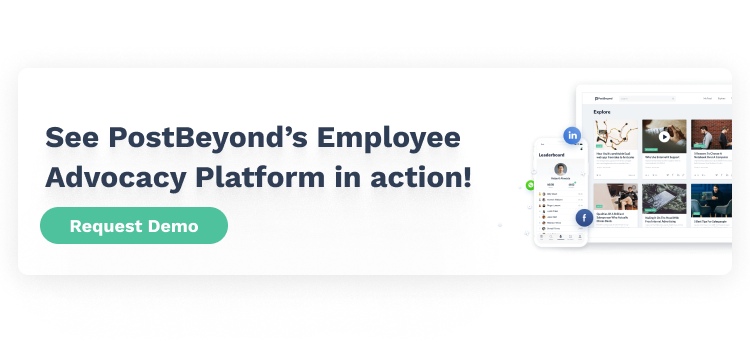Employee Advocacy in Enterprise
If you asked every one of your employees what your enterprise vision is – would they all give similar answers? Would your employees be able to confidently identify what you stand for and where your company is headed?
Research has shown that only 40% of the workforce can identify their company’s goals, strategies, and tactics.
With so many communication channels, it can be difficult to get everyone on the same page. Between outdated enterprise software, intranets, and email, it’s no wonder the vision gets lost. Employees don’t know where to receive information, they don’t know what current initiatives are running, and they don’t know what they’re allowed to share externally with friends and family.
But the problem isn’t your messaging – it’s how your corporate content is being disseminated.
Think of it this way: the current consumer app experience is visual, mobile, and social. Your employees are accustomed to receiving information this way outside of work. Why should corporate content be any different?
If employee needs and expectations aren’t being considered, it’s a perfect setup for widespread disengagement.
So what’s the cost of this? One disengaged employee costs your company an average of $3,400 for every $10,000 of salary. Now imagine this number multiplied by the number of disengaged employees spread across your enterprise.
You Already Have Employee Advocates
Fortunately, there’s evidence to suggest that employees want to engage with corporate content. Recent research has found that:
- One in five employees (21%) is estimated to be an employee advocate, and another 33% have high potential to be employee advocates (Weber Shandwick)
- 50% post messages, pictures or videos on social media about their employer.
- 39% have shared praise or positive comments online about their employer.
- 33% post messages, pictures or videos on social media about their employer without any encouragement from the employer.
- Almost 86% of employees participating in an employee advocacy program credited their involvement on social media as having a positive impact on their career.
And there’s further evidence to prove that a streamlined content experience can have a positive impact on departments across the enterprise.
Why is Employee Advocacy Important?
Stronger Sales Enabelement and Social Selling

The role of sales professionals is shifting toward helping and educating prospects, and this can only be done if your sales team is knowledgeable.
Offering a content experience that provides your sales force with up-to-date information that’s accessible on any device can have several benefits, including:
- 73% of Best-in-Class organizations have a centralized content library to help their team sell in different situations. (Aberdeen)
- Users of sales enablement content average 69% more revenue growth year-over-year compared to their peers who do not use sales enabled content.
- Nearly 64% of advocates in a formal program credited employee advocacy with attracting and developing new business, and nearly 45% attribute new revenue streams to employee advocacy. (Hinge Marketing)
- 27% of high growth firms (over 20% revenue growth) reported that an employee advocacy program shortened their sales cycle.
- 72.6% of salespeople using social selling as part of their sales process outperformed their sales peers and exceeded quota 23% more often. (Source)
Improved Brand Recognition and Visibility

Brands are constantly competing for attention online. Ad blocking and algorithm changes make it increasingly difficult for marketing and communications departments to have their content soon. When employees are actively involved in sharing your brand’s message, it has a significant impact on visibility.
- 79% of firms surveyed reported more online visibility once implementing a formal employee content sharing program. 65% reported increased brand recognition. (Hinge Marketing)
- Measurable benefits include:
- Increased web traffic (44.9%)
- Better search engine ranking (32.4%)
- Increased content downloads (24.6%)
- Messages shared by employees went 5X+ further than the same message shared on a brand owned channel.
- Brand messages are re-shared an average of 24x when distributed by an employee vs. the brand.
Better Talent Acquisition and Employer Branding

HR professionals are tasked with providing an exceptional employee experience, and part of this is ensuring a strong employer brand and high levels of employee engagement throughout the enterprise. Understanding changing employee expectations and offering a solution that improves the overall work experience has measurable benefits for your workforce, including:
- Socially engaged employees are more optimistic, inspired, connected, and tenured.
- 27% more likely to feel optimistic about their companies’ future
- 20% more likely to stay at their companies
- 15% more likely to connect to co-workers beyond their core teams
- Best-In-Class companies place emphasis on continuous employee learning, with 60% providing their employees with a central content hub for self-learning (compared to 49% of all others), and 35% providing mobile access to content (vs. 29% of all others.) (Aberdeen)
- Best-In-Class companies are 60% more likely to give their employees opportunities for “microlearning.”
- Increasing employee engagement investments by 10% can increase profits by $2,400/employee, per year. (Glassdoor)
- 78% of job seekers say that ratings and reviews from those on the inside (employees) are influential when deciding where to work.
Employees want to share content, and there’s a clear benefit in doing so. But unfortunately, most enterprises are invested in processes that are simply ineffective. These processes are either outdated, or they suffer from low response from employees.
Couple that with pressure from executives to increase employee engagement and show ROI from every campaign, and communications managers have quite a challenge. There’s a gap between what employees expect of their employers and what’s being offered to them.
If this gap persists, it perpetuates distrust between employees and the communications department. The more internal campaigns executed that don’t resonate with employees, the wider the gap.
Continuing to invest in inefficient processes suggests to your employees that you’re out of touch with their expectations. What incentive does this give them to stay with your company?
The Modern Corporate Content Experience
The solution to this problem lies in an enterprise app that delivers content in a way that employees expect:
If you meet employees on their preferred medium, this significantly increases the likelihood of adoption and usage among your employees. No more pressing “Send” and hoping that your content is well-received.
In fact, this kind of insight as to what your employees respond to is critical for this content experience to be successful. If you’re able to determine…
- What corporate content your employees consume
- What content they share with their personal networks
- How much value this has generated for your enterprise
This will make all future internal communications more successful.
Your executives will be able to see the value in this corporate content, too. Metrics and reporting will become more efficient, and you’ll gain visibility into what works for your employees.
And that’s the key to modernizing the employee experience.


